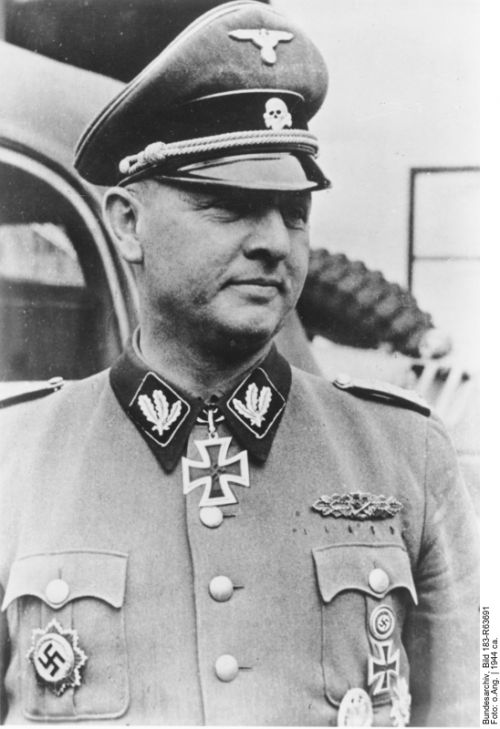Bruno Streckenbach

Bruno Streckenbach - (Bundesarchiv)
Bruno Streckenbach was born on February 7, 1902, in Hamburg, he was the son of a customs official. He joined the Hamburg police in 1933, and when the Nazis came to power, he was head of the Gestapo in Hamburg. When the Second World War began he then served in Poland, as head of Einsatzgruppe 1, which was located in the Neutitschen, Bielsko and Rzeszow areas. After November 1939, when this unit was disbanded, its personnel were assigned to SS and SD units in Krakow.
In Krakow Streckenbach was one of the leading architects of the mass arrests of the professors in the University of Krakow and Polish intelligentsia during May 1940, the infamous so-called 'Aktion AB,' which in German stood for 'Ausserordentliche Befriedungsaktion,' which resulted in the death of 3,500 intellectuals. He was promoted in January 1941, for the role he played in this 'aktion.' The Reich's Military Planning Committee planned the AB Aktion during February and March 1940, and Hans Frank Gouvernor -General ordered the 'aktion' to commence on May 16, 1940, within a week of the start of Hitler's campaign in the West.
The Germans arrested circa 3,500 Poles in the Generalgouvernement whom they considered underground leaders and 3,000 suspected of criminal activities, and these were murdered mainly in the infamous Palmiry Forest near Warsaw and at other sites. Among those Polish Intellectuals murdered were Maciej Rataj, Stefan Bryla, Taduesz Tanski Mieczyslaw Niedzialkowski and Janusz Kusocinski. The 'AB -Aktion' was planned to be completed by the middle of 1940, but in fact lasted well into the autumn of 1940, with executions in a number of locations, but whilst it depleted the ranks of the Polish underground, it did not succeed in eliminating Polish resistance, as envisaged.
On October 31, 1939, Streckenbach informed Hans Frank regarding RFSS Heinrich Himmler's intentions to deport Jews who lived in the areas of Poland now incorporated into the Reich and replace them with Poles who could be considered racially suitable for Germanisation. Under the decree dated November 28, 1939, within the Generalgouvernement the Jewish Councils (Judenrat) was placed under the control of the civilian authorities. Two days later at a meeting in Krakow attended by Hans Frank, Freidrich-Wilhem Kruger, Gustav Wachter and others, Streckenbach, the commander of the Security Police and Security Services in the Generalgouvernement informed the meeting that the Security Police were 'very interested in the Jewish question.'
Streckenbach wanted full control over the Judenrat, 'as sooner or later all questions pertaining to Jewish matters would have to be referred to the Security Police , especially if the contemplated action required 'executive enforcement,' but Hans Frank was strongly against this and protested, however, it was later agreed that the civilian authorities would co-operate with the Security Forces.

Himmler and Bruno Streckenbach in Krakow (Bundesarchiv)
As the first BdS, which stood for Befehlshaber der Sicherheitspolizei und des SD, in Krakow, Streckenbach was also involved in the Generalplan Ost, which was the Nazi plan for the expulsion of more than 50 million non-Germanised Slavs of Eastern Europe through forced migration, beyond the Ural Mountains and into Siberia. In their place up to 8-10 million Germans would be settled in an expanded living space, the so-called 'Lebensraum.'For his part in executing this plan Streckenbach oversaw the expulsion and re-location of approximately 88,000 Poles and non-Aryans from the former western Polish provinces into the Generalgouvernement. After serving in this role, Streckenbach was then sent to Berlin as the Director of AMT 1, the staff department of the Reich Main Security Office (RSHA).
Prior to the German invasion of the Soviet Union in June 1941, Bruno Streckenbach went to Pretzsch on the Elbe, at the end of May 1941, a three week training course took place, where handpicked members of the SD, Gestapo and the Police, were trained for service in the Einsatzgruppen. Streckenbach was tasked to train and indoctrinate these men, in the deadly role in the forthcoming conflict, where the four Einsatzgruppen (A, B,C, D) would operate. He detailed the mission of the Einsatzgruppen, which was to seize and destroy all political and radical enemy groups such as Political Commissars, Bolsheviks, Gypsies, Partisans and Jews. SS-Brigadefuhrer Streckenbach further ordered that all enemies of the Third Reich were to be deported to concentration camps and the Jews were to be singled out for 'special treatment' which actually meant extermination.
Streckenbach was put in charge of the Security Forces operating behind the front lines of Army Group North.On the 9 November 1941he was promoted to SS-Gruppenfuhrer und Generalleutnant der Polizei and in September 1942 he requested to join a front-line unit and he was transferred to the Waffen-SS with the rank of an SS-Obersturmfuhrer der Reserve and he trained with anti-tank units and joined the 8th SS Cavalry Division Florian Geyer.
Streckenbach won both the Knights Cross and the Oakleaves as Commander of the poorly equipped 19thVolunteer- Division of the Waffen –SS (Latvian Nr 2) while serving on the Russian front during the heavy fighting in the Baltic States. He was taken prisoner by the Russians and in 1952 he was sentenced to serve twenty-five years in prison, but was released on the 10 October 1955. During the Nuremberg Trial, Ohlendorf accused him and said that Streckenbach transmitted the extermination order at a meeting concerning the missions of the Einsatzgruppen in mid-June 1941.
Post-war attempts by the then West German to bring him to justice failed. He was brought to trial but in 1973 the case was dismissed due to his poor health, he died on the 28 October 1977 in Hamburg.
Sources
French L. Maclean, The Field Men, Schiffer Military History, Atglen, PA 1999
www.HolocaustResearchProject.org
Photographs – Bundesarchiv
© Holocaust Historical Society 2019

